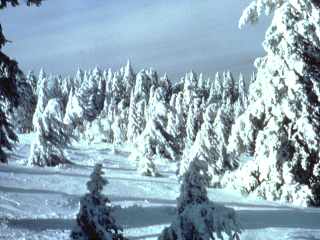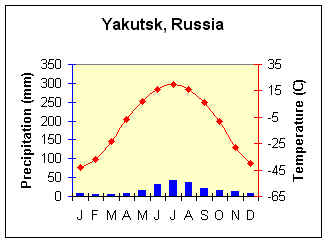9.6.1: Subarctic Climate
- Page ID
- 16105
Deep in the interior of high latitude continents lies the subarctic climate. Like the humid continental climate, continentality plays a major role in determining the characteristics of the subarctic climate. Bitterly cold winters and mild summers result in the largest annual temperature range of any climate on Earth.

Geographic Distribution
The subarctic climate is only found in the Northern Hemisphere because there is no large landmass at the same latitude in the Southern Hemisphere. Vast expanses of the subarctic climate stretch across northern North America from Newfoundland to Alaska. Subarctic climate is found in northern Eurasia from Scandinavia through most of Siberia.
Controlling Factors
Located in a large continental landmass between 50o to 70o latitude the subarctic climate is removed from any moderating influence of an ocean. It therefore experiences a very large range in annual temperatures. During the summer it is dominated by the Westerlies and cyclonic activity, during the winter it is the Polar High and Easterlies. The subarctic climate is noted for its long cold winters, no wonder given that it is found in the source region for continental polar air masses. Other air masses of significance are maritime polar and continental arctic.

Latitude/Longitude = 62.1oN; 129.49oW
Average Annual Temperature (oC) = -10.08
Annual Temperature Range (oC) = 63
Total Annual Precipitation (mm) =213
Summer Precipitation (mm) = 157
Winter Precipitation (mm) = 56
Distinguishing Characteristics
Temperature
The subarctic climate has brief, cool summers and bitterly cold winters. The subarctic experiences the lowest temperatures outside of Antarctica, and the largest annual temperature range of any climate. Though the summer is short, the day length is quite long with June days lasting 18.8 hrs at 60oN. Daytime temperatures can rise above 25oC (77oF), while dropping to 10oC (50oF) during the evening. The freeze free period is of course short, being only three months long. However, a freeze can occur in any month.
Precipitation
Total annual precipitation in the subarctic is fairly small, amounting to no more than 380 mm (15 in) to 500 mm (21 in) over the year. Most of the precipitation is cyclonic in origin and concentrated during the warmer months (except along coasts) where air masses are more humid. Notice that the summer precipitation at Yakutsk is three times that of winter. The extremely cold temperatures, coupled with the subsidence of the Polar High, are responsible for the meager precipitation that falls during the winter.


